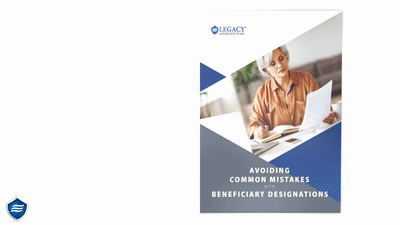One of the most critical decisions in developing an estate plan involves deciding the methods you’ll choose to distribute your assets — whether through a trust, beneficiary designations or your last will and testament. There are several factors to consider when deciding what estate planning tools to utilize for the distribution of your assets.
Beneficiary designations vs. trusts: more than just probate avoidance
For many people, the issue of probate avoidance is central to their estate planning strategy. While many people are aware that wills undergo probate — a public, often lengthy, costly and tedious court-supervised legal process to validate and administer a will — trusts and beneficiary designations both offer avenues to bypass this process. However, avoiding probate is just the tip of the iceberg regarding estate planning considerations.
In the intricate world of estate planning, beneficiary designations and trusts serve as two dominant threads, each with its unique attributes and implications.
Beneficiary designations, a common feature in insurance policies and retirement and other financial accounts, result in assets being directly transferred to the named individual shortly after your passing. This is efficient but lacks flexibility. It’s akin to an instantaneous transaction without any provisions regarding the circumstances involving the recipient.
On the other hand, trusts allow for detailed control over the timing and nature of asset distribution. For example, if you want to ensure your child only accesses their inheritance when they reach a particular age or milestone, trusts can help ensure that happens.
What are advantages of beneficiary designations?
One of the most prominent advantages of beneficiary designations is the speed at which the assets are transferred, bypassing the often cumbersome and protracted probate process. Also, it's a straightforward way to name a beneficiary, and it often just involves filling out a form provided by the financial institution or insurance company. By avoiding probate, beneficiary designations sidestep associated costs and legal fees. However, this simplicity and speed come at a cost: an inability to control the timing of when assets are received.
That’s important when you consider that life is unpredictable, filled with its share of ups and downs. A beneficiary designation, in its directness, cannot account for these shifts. If, for instance, a beneficiary is going through a challenging financial phase or a complicated divorce at the time of your passing, a direct transfer could put the assets at risk.
Meanwhile, for parents or guardians, this method offers no control if the beneficiary is a minor. There's no stipulation to ensure the child uses this inheritance wisely or at an appropriate age. The funds could end up being managed by a court-appointed guardian, which might not align with your wishes.
What are the three types of beneficiaries?
Beneficiaries are individuals, trusts, charities, estates or organizations designated to receive benefits or assets from various entities like insurance policies, wills, trusts, retirement accounts and other financial instruments. The classification of beneficiaries can differ based on context and the specific kind of asset or policy in question. However, in a broad sense, beneficiaries are commonly categorized into three main types:

- Primary beneficiaries: These are the first in line to receive the benefits or assets. If the primary beneficiary is alive at the time of the asset holder's death, they will receive the specified share of the assets. In many cases, people designate multiple primary beneficiaries. For instance, someone might designate two children as primary beneficiaries, splitting a life insurance payout equally between them.
- Contingent or secondary beneficiaries: These beneficiaries come into play if the primary beneficiaries are unable or unwilling to accept the assets or benefits. This could be due to reasons like predeceasing the asset holder or choosing to decline the inheritance. Essentially, if the primary beneficiary cannot claim the asset, the contingent beneficiary becomes eligible to receive it. This system ensures that the asset does not go to an unintended party or escheat to the state in the absence of a valid beneficiary.
- Per stirpes beneficiaries: These beneficiaries are another secondary line of succession. They will inherit or receive benefits if both the primary and contingent beneficiaries are unable to, and that beneficiary's share will be divided equally among their own descendants. Having a per stirpes beneficiary can offer an extra layer of assurance that assets will be allocated as the owner intended, even in complex or unexpected situations.
It's important to note that the designation and rules related to beneficiaries might differ based on regional laws, financial institutions and the type of account or policy. Periodically reviewing and updating beneficiary designations is crucial, especially following major life events like marriage, divorce, birth of a child or the death of a previously designated beneficiary. The proper designation ensures that assets are distributed according to one's wishes and can also help in avoiding potential legal disputes or complications after one's passing.
How do trusts provide flexibility?
Compared to beneficiary designations, trusts emerge as sophisticated tools, allowing for a high degree of customization over how, when and under what conditions your assets are distributed.
With trusts, you can stipulate age-specific distributions. For example, you might decide that a beneficiary receives a portion of their inheritance at 25, another at 30 and the remainder at 35. Beyond age, trusts can be structured around life milestones — like graduating from college, getting married or buying a first home.
Trusts also offer protection from life challenges. If a beneficiary is going through a tough phase — be it financial troubles, legal issues or addiction — a trust can have provisions to delay or modulate distributions. This can help ensure that the inheritance of a spendthrift isn’t squandered or seized during such vulnerable times.
How do trusts protect people with disabilities?

For beneficiaries with disabilities, trusts can be tailored to provide for them without jeopardizing their eligibility for governmental assistance.
When planning an estate, extra care needs to be taken for beneficiaries with disabilities. The primary concern is ensuring that they are provided for after your passing while also preserving their eligibility for crucial government assistance programs.
Individuals with disabilities might be eligible for various assistance programs, such as Supplemental Security Income (SSI), a federal program that provides monthly cash payments; Medicaid, a state and federal program that provides health coverage for people with low income, including some adults with disabilities; and other state-specific programs, such as housing assistance, food aid and other specialized services.
These programs often have strict income and asset limits. An unexpected influx of money or assets, such as an inheritance, can push an individual's resources above these limits, making them ineligible for these benefits.
For example, to be eligible for SSI, an individual might be limited to $2,000 in assets (the amount can vary and might be higher for couples). An inheritance of even a modest sum could easily surpass this limit.
Many assistance programs also have monthly income limits. A direct inheritance could be viewed as income for the month it's received, potentially disqualifying the beneficiary for that month or longer.
The flexibility of trusts shines brightest when considering the numerous unpredictable situations beneficiaries might find themselves in. Direct transfers through beneficiary designations can inadvertently put funds into the hands of a minor, someone going through a divorce, someone in debt, an incapacitated individual or someone reliant on government benefits. This lack of timing control can result in assets getting squandered, mismanaged or simply not fulfilling the purpose you intended for them.
How do trusts and beneficiary designations compare?
With a trust, if you need to revise beneficiaries or terms, it’s typically a straightforward amendment to one document. That is important because life is dynamic, and circumstances change. Contrast this with beneficiary designations, where each financial institution usually requires a separate update process.
While beneficiary designation forms are somewhat rigid, governed by the options they present, trusts are a testament to flexibility. They can be tailored to specific needs, potential scenarios and unique family dynamics. This flexibility is particularly beneficial when thinking long-term — today’s ideal plan might not fit the landscape a decade down the line. Trusts can better adapt to these uncharted waters.
Why is having a will important?
Wills have been used for centuries as instruments to express a person's final wishes. From determining how one's estate will be distributed to specifying guardians for minor children, a will remains an indispensable legal document in the realm of estate planning. While some may consider a will to be just another formality, its absence can have significant ramifications for both the deceased's estate and their loved ones.
Also, with all the advantages trusts and beneficiary designations offer, one might wonder about the relevance of wills. However, wills serve as an indispensable safety net. They act as a catch-all for assets that might not be covered by a trust or beneficiary designation, ensuring that no asset is left in limbo. A critical issue like guardianship for minor children is something trusts and beneficiary designations simply can't address. A will also can clearly outline how a person's assets are to be distributed upon their death. This clarity can eliminate the potential for disputes and misunderstandings among heirs and beneficiaries.
While often perceived as a morbid necessity, wills are truly about life, love and legacy. They ensure that one's values, decisions and desires are respected even after they're gone. The absence of a will can plunge families into legal and emotional turmoil, underscoring the document's indispensable nature. Crafting a comprehensive will, with the guidance of legal professionals, is a pivotal step in responsible estate planning. It stands as a testament to foresight, care and the enduring commitment to loved ones and cherished causes.
Conclusion
While it's enticing to boil estate planning down to simplistic choices for the sake of efficiency, the nuanced nature of life requires a more detailed approach. Trusts, with their adaptability and control, often offer a robust solution for those who want to ensure their legacy is not only preserved but also benefits their loved ones in the most efficient and appropriate manner.
However, this doesn’t diminish the importance of beneficiary designations and wills. Each serves its purpose, and a balanced combination ensures that your estate plan is both comprehensive and precise. After all, it's not just about transferring assets — it's about securing the future for those you cherish the most.



